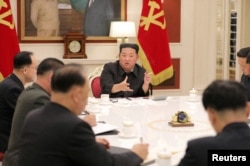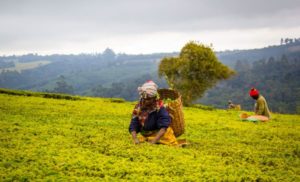SEOUL, SOUTH KOREA —
North Korea is organizing its own systemized response to a growing COVID-19 outbreak, with at least 1.7 million people coming down with fever since the “explosive” trend was noticed in late April.
Pyongyang has been indicating its suspected COVID-19 cases as “fever,” given a current inability to swiftly confirm COVID patients with broad testing. It has yet to vaccinate its roughly 26 million residents.
Another 232,880 people came down with the fever, state media KCNA said Wednesday, citing the state emergency epidemic prevention headquarters. The death toll climbed to 62, with the addition of 6 fatalities.
North Korea recognized its first COVID-19 death on May 13, posthumously assessed as the subvariant BA.2.
In a meeting of the Presidium of the party’s Political Bureau Tuesday, leader Kim Jong Un said the epidemic crisis was revealing an “immaturity” of the state’s response capacity. He blasted the “non-positive attitude, slackness and non-activity” of leading state officials in the prevention effort’s early days “in which time is life.”
Kim pressed for unconditional unity across all bodies of power and societal sectors to the decisions of the Party Central Committee, KCNA said, as the Presidium examined and evaluated “the justness, efficiency and scientific accuracy of the state emergency epidemic prevention policy now in effect.”
Members of the meeting were notably unmasked in pictures issued by state media.
‘Anti-epidemic struggle’
Separately, KCNA detailed prevention measures being implemented across the under-resourced state. At the epicenter in Pyongyang, some 3,000 military personnel were delivering medicines to hundreds of pharmacies in a “well-organized 24-hour service system.” In cities and provinces beyond, senior officials were tasked with supplying medicines to ensure they reached even the remotest areas.
More than 1,428,000 teachers, students and officials in public health were checking and treating people for fever. Later KCNA said almost “500 rapid mobile anti-epidemic groups and rapid diagnosis and treatment groups” were confirming and treating infected people. It was unclear how the patients were being diagnosed.

On a state level, a new command system was established “to more intensively conduct the emergency epidemic prevention work,” as scientists and researchers stepped up the development of treatments as well as “more rational” diagnosis methods for the “malignant virus infection.”
It noted major economic projects were propelling forward as scheduled, as farming activity forged on in the crucial rice planting season.
Testing: COVID-19, weapons
North Korea state media’s rather detailed account of COVID-19 control efforts comes as the nuclear-armed state is likely preparing for more provocative weapons testing.
Another intercontinental ballistic missile test appears imminent, South Korea’s Deputy National Security Advisor Kim Tae-hyo told reporters Wednesday, adding a nuclear test over the weekend is assessed as unlikely.
U.S. President Joe Biden is due to arrive in the region for visits with the leaders of South Korea and Japan starting on Friday. In Tokyo, he will also meet with Quad member nations, which includes Japan, Australia and India.
Strategic assets and a Plan B have been readied should a serious provocation occur during Biden’s three-day visit of South Korea, Kim said.
“This is ultimately unsurprising, despite the acknowledged ‘fever’ crisis’,” Ankit Panda, a nuclear policy specialist at the Carnegie Endowment for International Peace said in a Twitter post. “North Korea has used the accomplishments of the national defense industry as a beacon in the dark economic times of the last two years. And it ultimately seeks more robust capabilities.”
Washington does not believe North Korea’s viral outbreak will delay any plans to revive nuclear weapons testing. “We have never seen the DPRK regime prioritize the humanitarian concerns of their own people over these destabilizing programs that pose a threat to peace and security in the Indo-Pacific and beyond, so I do not think there is any expectation of that,” State Department Spokesperson Ned Price said Tuesday.
The North has remained unresponsive to offers of humanitarian help from South Korea and international organizations amid reports it may be transporting supplies from China.
Three airplanes marked Air Koryo, North Korea’s flag carrier, reportedly brought in medical supplies, according to South Korean media, after departing from Shenyang Taoxian International Airport in China’s Liaoning Province on Monday.
Citing customs data on North Korea-China trade in the first quarter, VOA’s Korean Service said Pyongyang purchased a larger quantity of masks and medical supplies compared to volumes reported for the same period last year. Vitamins, antibiotics and unmarked vaccines were among items imported in the January through March period, while aid shipments from international organizations remained on standby on the Chinese side.
The World Health Organization said it was still waiting to be notified of North Korea’s COVID-19 situation by relevant state officials, offering “technical support to scale up testing, strengthen case management, implement situation specific public health and social measures, and provide essential medical supplies and medicines.”




